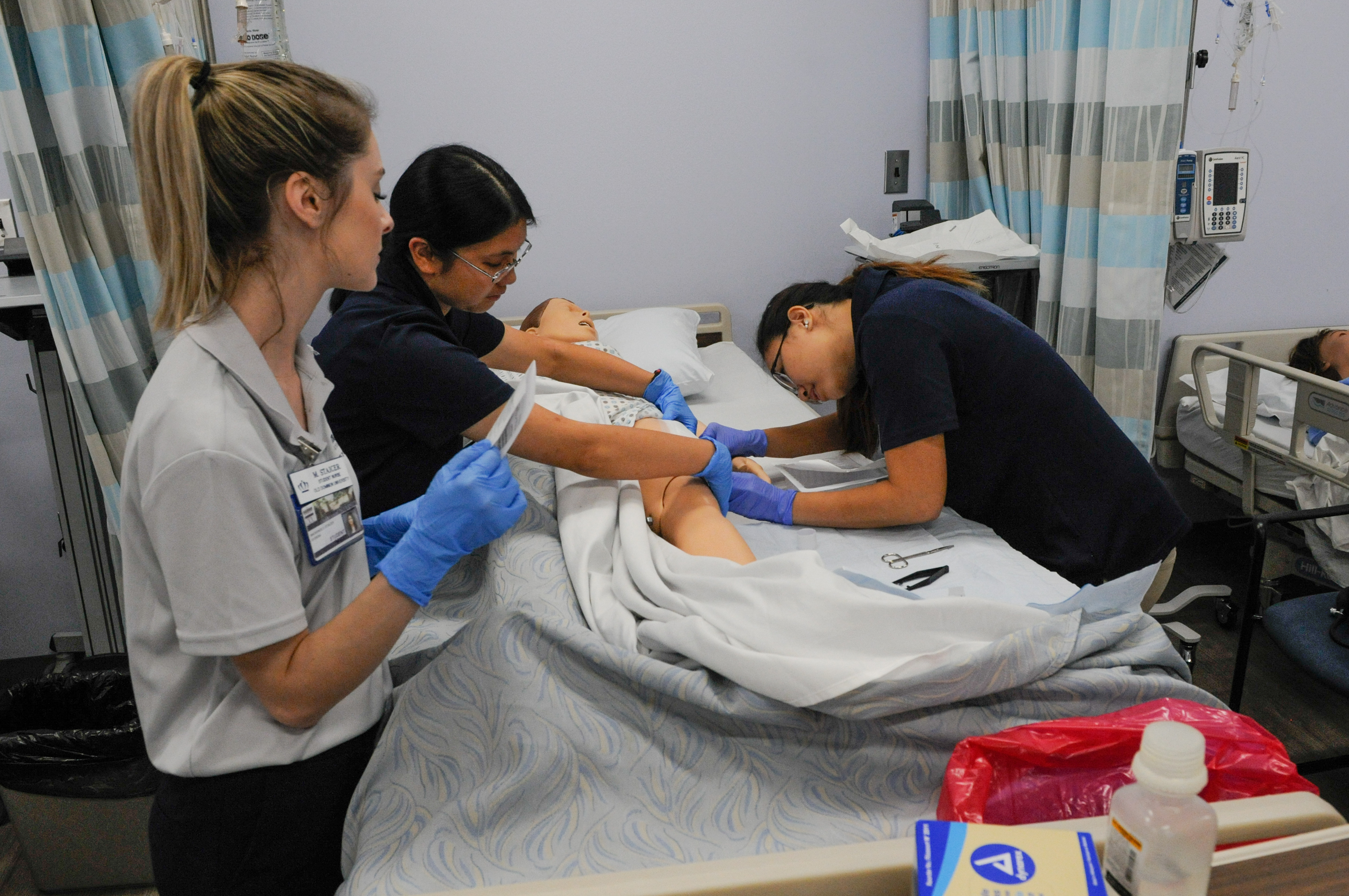Life in Hampton Roads Survey Shows Highest Percentage of Poor Health Respondents in the Past Five Years
January 03, 2019
 Old Dominion University celebrated a $1.3 million expansion of its health sciences programs and the establishment of a new Center for "Telehealth" Education and Research at the Virginia Beach Higher Education Center. Photo Chuck Thomas/ODU
Old Dominion University celebrated a $1.3 million expansion of its health sciences programs and the establishment of a new Center for "Telehealth" Education and Research at the Virginia Beach Higher Education Center. Photo Chuck Thomas/ODU
This report examines regional and subregional measures of health and health-related issues from the 2018 Life in Hampton Roads survey (LIHR 2018) conducted by the Old Dominion University Social Science Research Center. Data from prior years is also provided when available to show comparisons in responses. Responses were weighted by city population, race, age, gender and phone usage (cell versus land line). For additional information on survey methodology, and analyses of other issues, please see the SSRC website at www.odu.edu/ssrc.
The health of Hampton Roads residents is vital to ensuring that the community thrives. The 2018 Life in Hampton Roads survey asked residents about their general health, certain health conditions, health insurance and other health-related questions. Many of these questions were developed by the Virginia Beach Department of Public Health and its partners.
General Health
A total of 29.6 percent of respondents rated their general health as excellent. A majority (52.1 percent) reported themselves to be in good health, while 13.7 percent stated that they are in fair health. The percentage of those reporting that they have poor general health increased slightly, to 3.9 percent in 2018 compared to 3.2 percent in 2017. This is the highest percentage of respondents reporting being in poor health in the past five years.
Across the cities of Hampton Roads, Suffolk and Norfolk residents reported the highest ratings of overall health, with 86.0 and 84.4 percent reporting their health good or excellent, respectively. Alternatively, Portsmouth (78.7 percent) and Hampton (74.2 percent) had lower percentages of residents who rated their overall health excellent or good.
Health Care Visits & Health Insurance
Respondents were asked where they go to receive care when they do not feel well. The majority (66.0 percent) said they visit a general practitioner or family doctor. Additionally, 14.6 percent said they go to an urgent care center and 10.7 percent go to the emergency room. Just 7.5 percent said they do not see a medical professional.
Respondents also were asked to identify who pays for their primary health insurance. The majority reported that it is either funded by private insurance through their employer (40.0 percent) or through government-funded insurance, such as Medicaid, Medicare or military or veterans coverage (32.9 percent). Another 14.3 percent said they purchased private insurance coverage themselves, and 8.2 percent said they do not have health insurance.
The survey also included questions about barriers to healthcare, including if respondents were unable to see a healthcare provider when they wanted to for various reasons. The majority of respondents (80.4 percent) reported that none of the reasons listed applied to them. Of the reasons reported for not being able to see a healthcare provider, the three most common were cost (11.5 percent), unable to get time off work (6.4 percent) and no available appointments (5.2 percent).
Chronic Conditions
Respondents were asked whether a doctor had told them they had certain medical conditions within the past three years. The most common one was high blood pressure or hypertension (22.0 percent). After that, there was a substantial drop-off, with only 7.9 percent saying they had been told they had diabetes and 5.1 percent being told they had some other medical condition. The majority of respondents (66.5 percent) reported that a doctor had not told them they had any medical conditions.
About one-third (33.6 percent) of respondents reported that their doctor has asked about their mental health in the past 12 months. Additionally, respondents were asked whether a doctor had told them they had certain behavioral health conditions within that same time frame. The two most commonly reported behavioral health conditions were anxiety (11.9 percent) and depression (11.2 percent). Again, the majority of respondents (79.3 percent) reported that a doctor had not told them they had behavioral health conditions.
Healthy Habits
Respondents were asked how often they follow the advice of a healthcare provider if they are told they need to have a preventative screening, such as a mammogram, colonoscopy or other procedure. The vast majority reported that they either always (61.1 percent) or often (21.2 percent) follow the advice. Only 6.5 percent stated they either rarely (3.1 percent) or never (3.4 percent) follow the advice.
When asked how many servings (1/2 cup) of fruits and vegetables they have on an average day, the majority of respondents said they have either 1-2 servings (50.9 percent) or 3-4 servings (34.0 percent). Another 9.6 percent said they have five or more servings and only 4.9 percent said they have no servings.
The majority of respondents exercise for 30 minutes or more at least one day a week (81.7 percent) with 24.2 percent exercising 1-2 days a week, 29.5 percent exercising 3-4 days a week, and 28.0 percent exercising 5-7 days a week. Only 18.2 percent said they do not exercise for 30 minutes or more during the week.
Tobacco, Alcohol and Prescription Drugs
The majority of respondents stated they do not use tobacco products (81.2 percent). Additionally, 93.0 percent said they have never failed to do what was expected from them because of drinking alcohol. A small percentage (4.2 percent) said they had failed to do what was expected from them less than monthly (2.7 percent) or monthly (1.5 percent).
Respondents were also asked how they typically dispose of unused or unwanted prescription medications. Almost half (47.9 percent) said they keep or finish all medications. Another 23.6 percent reported they throw them away. Additionally, 15.9 percent bring them to a take-back program and 12.2 percent flush them down the toilet. The vast majority of respondents also stated that they have not used prescription drugs other than those prescribed to them in the past 12 months (93.7 percent).
Advanced Health Care Planning and Aging
Respondents were asked if they have heard about and completed an advance care directive, such as Health Care Power of Attorney (HPCA) in which they name someone to make their health care decisions in the event they become incapacitated. The majority (73.2 percent) reported that they have heard of an advanced care directive, with 37.2 percent having completed one and 36.0 percent having not completed one. Almost one in five respondents (23.9 percent) said they have not heard about an advance care directive. Additionally, 26.6 percent of respondents said they have used hospice services to care for a family member or loved one.
Respondents were asked to identify health issues that concern them about aging. The most common response was memory problems, dementia and Alzheimer's disease (46.1 percent). More than one-third cited problems walking and balance issues/falls (36.7 percent) and vision loss (36.1 percent). A slightly smaller percentage were concerned about hearing loss (30.0 percent), loneliness and not being able to have as many social interactions (27.5 percent), and urinary incontinence and bladder problems (26.9 percent). Just under one-third (30.6 percent) said they did not have any concerns.
Residents were asked how they would rate their community as a place for people to live as they age. Almost half (42.4 percent) said their community was a good place and another 18.8 percent said their community was an excellent place. Additionally, 27.6 percent stated their community was a fair place and 9.3 percent said their community was a poor place. Responses varied significantly across cities, with Suffolk having the highest percentage rating their community as an excellent or good place (73.8 percent) and Newport News (49.4 percent) having the lowest. Respondents were also asked which resources they think are the most important for the senior population. The most common responses were health and wellness programs (25.0 percent), medication management (18.9 percent), transportation assistance (14.3 percent) and assistance with financial matters (10.7 percent).
When asked how easily accessible substance use/abuse resources and treatment options are in their community, about one-third (33.2 percent) said they are widely available. Another 21.3 percent said that resources and treatment options are very limited and 7.2 percent said they are not available. More than one-third of respondents (38.4 percent) said they either did not know if resources and treatment options were available in their community or refused to answer.




